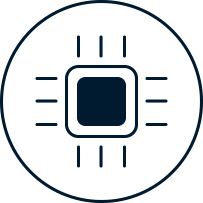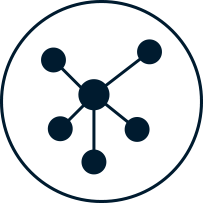Mobile app development
You want to create an app and are looking for a comprehensive overview from the idea to the finished application?
We accompany you step-by-step to the successful development of your own app.
_Workshop
Developing the idea
Everything starts with your idea. During a workshop, we define the purpose of your app and identify the problems or needs it should solve.
Target group analysis
In order to position your app successfully, a precise target group analysis is essential. We work with you to identify your potential users and their preferences, habits and needs. These findings help us to work together to develop an app that is specifically tailored to your target group.
Define functionalities
We work with you to define the core functionalities of your app. What features are needed to solve the main problem or achieve the main goal? We prioritize these features to ensure your app can be tried out as quickly as possible in relation to the customer.
_UI/UX
Design and UI
An appealing and user-friendly design is of great importance. Design an intuitive user interface (UI) that makes it easy for users to use the app. We pay attention to a consistent design, color scheme and clear navigation.
_Development
Developing the app in sprints
Developing a mobile app in sprints allows the team to react flexibly to changes, integrate continuous feedback and create a high-quality app in iterative steps. This approach promotes transparency, team collaboration and continuous improvement of the development process. With you as part of the scrum team, we can deliver the best possible result for you.
_Why and how do we use Scrum to develop your app?
What is Scrum?
Why is “flexible to change” so important and what does it have to do with the competitive environment?
What is optimization and improvement all about?
_Scrum leads to more transparency and communication, but why is this important?
Why do we use Scrum?
Who is part of the Scrum team?
How does a sprint usually work?
COMMUNICATION
Actually, we talk to every customer about communication again and again, because that’s exactly where many software projects fail.
In their role as product owners within our joint software development, our project managers ensure as much communication as possible. And for a variety of reasons, but here are the most common ones:
Interaction with you
Communication with you is absolutely crucial to ensure that the developed product meets your needs. Regular updates, presentations and discussions make it possible to review progress, provide feedback and make adjustments.
Understanding the requirements
Clear communication helps to understand the requirements and expectations for your software project. Developers need to understand exactly what the application is supposed to achieve to ensure they implement the right features and deliver the desired results.
Teamwork
Software development is often a team process in which different members with different skills and areas of expertise work together. Effective communication promotes collaboration, facilitates the sharing of knowledge and ideas and enables the team to work together on a solution. You as the product owner also interact with the team and our teams get to know you and your industry better and better. This makes communication increasingly easier.
Avoiding misunderstanding
Unclear or incorrect communication can lead to misunderstandings, which can result in errors, delays or inefficient work processes. Clear and precise communication reduces the risk of misunderstandings and contributes to the quality and punctuality of the project. Misunderstood requirements can lead to weeks of development in the wrong direction. With regular presentations (every two weeks), we ensure that misunderstandings are quickly uncovered.
_What makes good UI/UX design?
Good UI (User Interface) and UX (User Experience) design are crucial to develop a user-friendly, engaging, and effective software or app. Here are some important aspects that make good UI/UX design:
SUMMARIZED...
In summary, good UI/UX design aims to create a seamless, efficient, and enjoyable user experience that meets users’ needs while being aesthetically pleasing. It takes into account both visual design and user interaction to create an application that is user-friendly, engaging, and successful.
_User Interface (UI)
Clarity and simplicity
A good UI design is characterized by clear and simple elements. The user interface should be intuitively understandable so that users can navigate without confusion.
Consistency
Consistency in colors, fonts, buttons and icons creates a harmonious and familiar user experience. A uniform design makes it easier for users to find their way around the platfor
Responsive design
The UI should work well on different devices and screen sizes and adapt automatically to provide an optimal user experience.
Aesthetics
An appealing design with aesthetically pleasing colors, shapes and layouts helps to increase the visual appeal of the user interface.
Visible hierarchy
An effective UI design provides a clear hierarchy of information and elements. Important functions and content should be displayed more prominently than less important ones.
_User Experience (UX)
User-centered approach
Good UX design starts with a deep understanding of users and their needs. The design should focus on how users use the application and what goals they want to achieve.
Empathy
A good UX design shows empathy for the user. It takes into account their emotions, needs and frustrations to create a pleasant and satisfying experience.
Efficient navigation
The application should provide clear and intuitive navigation to allow users to easily find what they are looking for and seamlessly switch between the different parts of the app.
User feedback
Interaction feedback, visual feedback and clear notifications help users understand what is happening in the application and minimize confusion.
Fast loading times
Fast performance and short loading times are crucial for a positive user experience. Long waiting times can be frustrating and affect user retention.
A/B testing and iteration
Good UX design involves regular testing and iteration to ensure that the application is continuously improved and meets the changing needs of users
SUMMARIZED...
In summary, good UI/UX design aims to create a seamless, efficient, and enjoyable user experience that meets users’ needs while being aesthetically pleasing. It takes into account both visual design and user interaction to create an application that is user-friendly, engaging, and successful.
_User Interface (UI)
Clarity and simplicity
A good UI design is characterized by clear and simple elements. The user interface should be intuitively understandable so that users can navigate without confusion.
Consistency
Consistency in colors, fonts, buttons and icons creates a harmonious and familiar user experience. A uniform design makes it easier for users to find their way around the platfor
Responsive design
The UI should work well on different devices and screen sizes and adapt automatically to provide an optimal user experience.
Aesthetics
An appealing design with aesthetically pleasing colors, shapes and layouts helps to increase the visual appeal of the user interface.
Visible hierarchy
An effective UI design provides a clear hierarchy of information and elements. Important functions and content should be displayed more prominently than less important ones.
_User Experience (UX)
User-centered approach
Good UX design starts with a deep understanding of users and their needs. The design should focus on how users use the application and what goals they want to achieve.
Empathy
A good UX design shows empathy for the user. It takes into account their emotions, needs and frustrations to create a pleasant and satisfying experience.
Efficient navigation
The application should provide clear and intuitive navigation to allow users to easily find what they are looking for and seamlessly switch between the different parts of the app.
User feedback
Interaction feedback, visual feedback and clear notifications help users understand what is happening in the application and minimize confusion.
Fast loading times
Fast performance and short loading times are crucial for a positive user experience. Long waiting times can be frustrating and affect user retention.
A/B testing and iteration
Good UX design involves regular testing and iteration to ensure that the application is continuously improved and meets the changing needs of users






